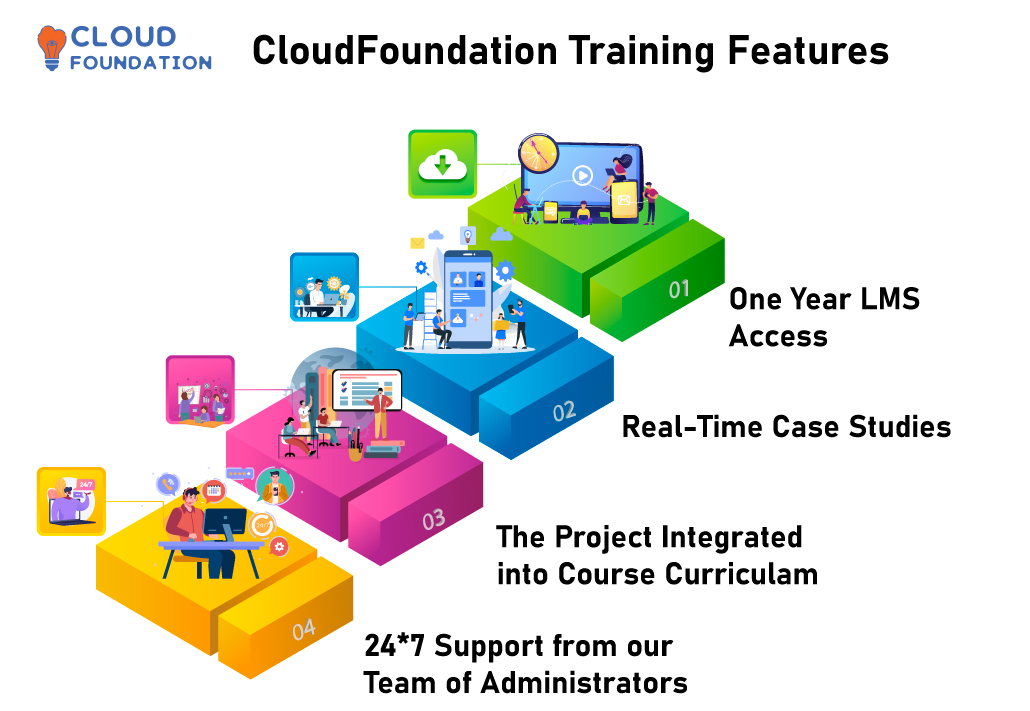Mulesoft Training – The only ESB Course you need
⏰20 hours | ▶️ 22 Videos | 📣 221 Participants | 🎓 3481 Reviews | 4.8 ⭐⭐⭐⭐⭐
Choose a Plan that Works for You
Self Paced
- Advanced sessions
- Interview Q&A
- Free study Materials
- Premium Technical support
Instructor Led Live Training
- Live Instructor
- Advanced sessions
- Interview Q&A
- Premium Technical Support
Corporate Training
- Live Instructor
- Advanced sessions
- Interview Q&A
- Premium Technical Support
Upcoming Batches PST
Weekend
| Jan 12(1 HR A DAY) |
| 06:30 PM PST |
| Enroll Now → |
Weekday
| Jan 30(1 HR A DAY) |
| 06:30 AM PST |
| Enroll Now → |
Weekend
| Jan 24(1 HR A DAY) |
| 07:30 PM PST |
| Enroll Now → |
Upcoming Batches IST
Weekend
| Jan 13(1 HR A DAY) |
| 07:00 AM IST |
| Enroll Now → |
Weekend
| Jan 30(1 HR A DAY) |
| 06:30 PM PST |
| Enroll Now → |
Weekend
| Jan 25(1 HR A DAY) |
| 08:00 AM IST |
| Enroll Now → |
Course Description
Cloudfoundation’s MuleSoft Training will advise you on the principles of data integration, and you can sign up for it here.
Do you want to find out how to relocate data, edit data, and combine data so that it may be utilized to fuel your company’s architecture?
This MuleSoft Class was made with people exactly like you in mind when it was created! MuleSoft Training will provide you with the skills necessary to handle the robust MuleSoft platform, which you will be able to do after completing the training.
You will be able to simplify the process of merging data from a variety of sources in a way that is both safe and up-to-date thanks to the availability of this.
This thorough MuleSoft course will teach you not only the theoretical aspects of data integration and other difficulties but also the more practical aspects of using MuleSoft and the Mule ESB as well.
The theoretical aspects of data integration and other issues are only some of the topics that will be covered.
You will begin by gaining a fundamental understanding of the capabilities and services offered by MuleSoft Online Training.
Because of this, it is necessary to have a solid understanding of the fundamental ideas that lie behind corporate data integration, the general architecture of MuleSoft, as well as the fundamental ideas behind getting started with the Mule enterprise service bus.
After that, you will receive an in-depth look at how to work with MuleSoft Any point Studio, which is a graphical user interface (GUI) for developing, testing, and deploying integration apps that are based on the Mule runtime engine.
After that, you will go on to the next segment. Once you have proficient that, the class will be considered complete for you.
You will also get an in-depth introduction to the elements of MuleSoft that are regarded to be its most important components.
Some examples of these elements include the following:
• Routing of messages through the use of the Mule enterprise service bus
• Connectors that allow for integration with a broad number of data sources, such as JDBC, JMS, and SFTP
• Innovative, cutting-edge, and cutting-edge disruptive strategies and methodologies utilizing MuleSoft
• Taking Advantage, Within Your Projects, of the Scripting Components Offered by MuleSoft
• Application Programming Interfaces, or APIs, as well as RESTful services, which are both provided by MuleSoft
• Encrypting sensitive data in order to protect it and forcing users to verify themselves with credentials in order to access the system
• Configuring MuleSoft apps to run on a cluster consisting of many servers
As you move through the different sections of this MuleSoft Certification Course, you will gain practical experience by putting the different ideas that are covered in the lectures into practice on your own.
We will supply you with the tools you need, as well as situations that are modeled after actual occurrences, so that you may put what you’ve learned into action.
These scenarios will be based on actual events. At the end of this course, you will also have the capacity to combine data coming from a range of different sources.
As mentioned CloudFoundation is the ideal online infrastructure for you! This course provides a comprehensive overview of the cloud services industry and teaches essential skills such as how to use cloud services, architecture, security, operations, automation, business analysis, and more.
We provide hands-on tutorials and detailed instructions to help you comprehend best practices and develop expert-level cloud skills.

Course Content
1. Introducing API-Led Connectivity
*Where to Start? * Why Mulesoft? * API-Led Connectivity
* Describe API-driven connectivity.
* Advantages of Using Mulesoft
* Exactly what does Anypoint Platform entail?
* A Definition of Web Services and Application Programming Interfaces
* APIs: Listings and Access Points
* Connect to both private and public APIs
* Integrate Anypoint Platform’s API-driven connection.
2. Designing APIs
* RAML and API?
* What exactly is the Restful API Modeling Language?
* Create a portal for developers; Mock an API to test the design before it is developed
* Explain how to utilize an API.
* Add an API to the private Exchange to make it discoverable.
3. Building APIs
* Application, Flow, Message, and Message Processor in Mule * What are they?
* Make a graphical process flow with Anypoint Studio.
* Create, test, and execute a Mule application.
* Connect to a database using a connector. Transform data using the graphical DataWeave editor.
* Create a RESTful interface from a RAML file.
* Run and test a Mule application
* Connect to a database via a connector
* Edit data transformations graphically in the DataWeave editor
* Connect an API interface to the resulting implementation.
4. Deploying and Managing APIs
* How to deploy Mule apps
* Using Mulesoft’s properties, which make it simple to move applications between environments
* Deploying Mule applications to the cloud
* Building and deploying a cloud-based proxy for an API
* Restricting access to an API proxy
* PART 2: Using Anypoint Studio to Create Applications.
5. Accessing and Modifying Mule Messages
* Read and write message properties.
* Log message data.
* Debug Mule apps.
* Mule Expression Language (MEL) is used to create expressions.
* Develop variables.
6. Structuring Mule Applications
* Create and reference flows and subflows
* Use the Java Virtual Machine (VM) transport to pass messages between flows
* Examine variable persistence through flows and subflows and across transport barriers
* Organize global components in distinct configuration files
* Examine the Mule project’s contents and organizational structure.
7. Consuming Web Services
* Consume SOAP web services
* Consume RESTful web services
* Consume RESTful web services with and without parameters
* Consume RESTful web services with RAML definitions.
8. Handling Errors
* Identify the various exception management techniques.
* Handle messaging exceptions in flows.
* Use global exception handlers.
* create them Set a global default exception policy.
9. Controlling Message Flow
* Multicast messages
* Route messages based on requirements
* Filter messages
* Validate messages.
10. Writing DataWeave Transformations
* DataWeave expressions can be written for simple XML, JSON, and Java transformations.
* DataWeave transformations can be stored in external files;
* DataWeave transformations may be written for large data structures with repeating elements.
* DataWeave operators
* Defining and utilizing custom data types
* Calling MEL functions and Mule flows from DataWeave transformations
* Converting and formatting texts, integers, and dates.
11. Connecting to Additional Resources
* Poll resources.
* Connect to JMS queues.
* Connect to SaaS applications .
* Connect to files.
* Find and install connectors not included with Anypoint Studio.
12. Processing Records
* The For Each scope can be used to process items in a collection one at a time
* The batch job element (EE) can be used to process individual records
* A poll can be used to initiate a batch job
* And a batch job can be used to Synchronies data between an ageing database and a cloud service.
FAQ’s
❓What is MuleSoft is used for?
✅ MuleSoft offers a brand-new, integrated approach to automation, integration, and Application Programming Interfaces (APIs) that makes it simple for your team to automate any system or procedure. Your team will benefit from being able to quickly react to change and business complexity.
❓Is MuleSoft a programming language?
✅ Mule is a MuleSoft-provided enterprise service bus (ESB) and integration framework.
❓What is Mulesoft ?
✅ Event-driven architecture (EDA) and Mule Enterprise Service Bus are planned applications for MuleSoft Anypoint (ESB). In order to facilitate association modification and improvement more quickly, MuleSoft combines this by simply connecting apps, data, and devices via APIs. Accept the request, and be sure to include the client’s criteria in the structure. At this point, customer feedback can be recovered.
❓What is Mulesoft Developer ?
✅ A Mulesoft developer is a person who works in the MuleSoft environment and creates APIs for integrating customers’ systems using tools like Anypoint Studio or other smaller MuleSoft products.
❓What is Mulesoft Technology ?
✅ Business Service for Mule Bus is a type of middleware that allows for the safe and efficient transfer of information within a company. Mule as an ESB is a Java-based middleware solution that is both user-friendly and scalable, unlike most other middleware products. To connect two different systems, it might serve as the middleware in both cases.
Suggested Courses




WorkDay Training
⭐⭐⭐⭐⭐
😃 158 Learners




Tibco SpotFire Training
⭐⭐⭐⭐⭐
😃 79 Learners




SailPoint Training
⭐⭐⭐⭐⭐
😃 106 Learners




Pega Training
⭐⭐⭐⭐⭐
😃 391 Learners
A few of our students
















Contact Us